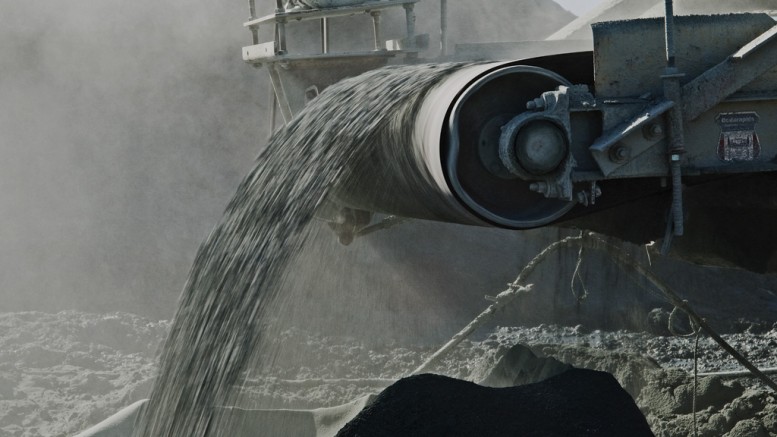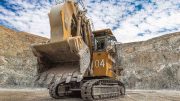A new means of exploiting previously overlooked zones of gold mineralization may prove to be the type of disruptive technology needed once the global COVID-19 pandemic is over.
Called sustainable mining by drilling (SMD), it uses a unique, surface-based drilling system to get at narrow vein deposits that have been considered uneconomic using existing mining techniques.
SMD’s creators believe the technology offers a cost-effective means of accessing known deposits while doing so with a smaller environmental footprint, reduced labour costs and increased safety for the system’s onsite operators.
The technology was developed by Toronto-based Anaconda Mining (TSX: ANX; US-OTC: ANXGF), which operates the Pine Cove open-pit gold mine and mill in the Baie Verte region of north-central Newfoundland.
Kevin Bullock, Anaconda’s president and CEO, says they knew there could be steeply dipping (at least 50-90 degrees) linear ore veins measuring less than 1.5 metres in width that were being ignored, and they wanted to find a viable means of mining them.
“There are literally thousands of deposits around the world, hundreds in Newfoundland alone,” Bullock says, noting that many are “too small and too narrow to justify the capex of a regular mining operation.”
But they’re high grade. “You can make a lot of money off small tonnes if the grade is there and you can figure out how to get it,” he says in an interview. “And this is a way to do that.”
In 2015, Allan Cramm, Anaconda’s vice-president, innovation & development, approached the company’s president with an idea to address the challenge of getting at these particular deposits. Cramm thought they should explore a homegrown solution by working with faculty and researchers at Memorial University (MUN) in St. John’s, Newfoundland.
With Anaconda’s support, Cramm forged a collaboration with Stephen Butt, a geological engineer and professor in MUN’s engineering and applied science department.
“Memorial University doesn’t have a mining program, and these researchers have no real mining background,” Cramm explains. “So initially, for the first five or six months, they sought to modify conventional technology, things like jackleg drills and Alimak mining methods. But nothing was working.”
At that point, the team realized they needed to rethink their approach. As Cramm recalls, this is when he and Butts knew the project needed to pivot into new territory.
“Steve’s background was leading the drilling technology laboratory, which was really set up to service the offshore oil industry in Newfoundland,” Cramm says. “So he and I chatted about putting some of the oil and gas drilling technology into mining applications. And that’s when things really took off.”
For the next several years, the MUN researchers embraced the idea of thinking outside the box, as they adapted technology from the offshore oil and gas sector into what would become the SMD concept. This involved augmenting existing directional drilling equipment and ground penetrating radar technology with innovative improvements geared specifically toward the mining sector.
SMD involves a two-pass drilling system that uses high resolution, subsurface imaging to identify the physical shape of a vein, and directional drilling that is flexible enough to deal with changes in the vein geometry.
On the first pass, a pilot hole is made by a diamond drill, guided by what is called a near borehole imaging tool (NBIT). The NBIT does downhole surveys at regular intervals, measuring the hole trajectory and distance from the hanging wall to the foot wall.
The second pass follows the pilot hole but utilizes a large diameter hole opening (0.5-3.0 metres) to excavate the vein out to its full thickness between the walls. The cuttings are then transported to the surface as a slurry, using low energy, reverse circulation air-lift assist methods that bypass grinding.
In addition to incorporating technology from outside the mining sector, Cramm says there’s a long list of other aspects of the technology that make it disruptive.
“It reduces the cost to extract this ore considerably, leveraging greater yields from existing mines,” he notes. “It reduces the environmental footprint considerably. It reduces the number of people required and, more importantly, places operators in a safe location on the surface. We’re doing for the mining industry what drones have done for military pilots: putting the operator out of harm’s way.”
Cramm adds that an SMD operation can be operated by as few as three people, and that the cost to extract ore using it is about half per tonne compared with conventional techniques.
SMD’s public debut occurred when Anaconda participated in the #DisruptMining event sponsored by Goldcorp at the Prospectors & Developers Association Convention (PDAC) in 2019. Though their pitch did not win, they were the only Canadian firm to make it to the finals, and the positive feedback gave them the confidence to push forward.
After five years of labour and almost $5 million spent on development, Anaconda’s Bullock says the firm decided to create a subsidiary to oversee SMD’s next steps. That venture-backed start-up, Novamera Inc., is now targeting an integrated trial of SMD technology in June 2021, for what is called a Generation 1 Minimum Viable Product (MVP).
But interest in the technology is already beginning to build in parts of the gold mining community, Bullock says. Vancouver-based junior Asante Gold (CNSX: ASE; US-OTC: ASGOF) believes that SMD could prove an effective means of extracting ore at their Kubi project site in Ghana.
“This is spectacular timing for us because our Kubi site is closer to two metres in width,” says Douglas MacQuarrie, Asante’s president and CEO. “I’m a geologist. I like finding gold. But as a CEO you have to look at the financial side of [extraction]. So I ran this by our vice-president, who happens to be a mining engineer, and he said this will work.”
MacQuarrie cautions that after his team looked at SMD, it was clear that this technology would not work for flat line targets and that the ore bodies need continuity that is quite planar. Luckily for Asante, their Kubi project has the type of geology that makes it perfectly suited to using this new extraction technology.
“I am convinced this technique will work, and I am convinced it’ll work at costs that are far lower than the [existing] technology out there,” MacQuarrie says. “If we can get the costs of mining a tonne of ore down from $100 a tonne to $30 a tonne, that’s phenomenal. For our particular business plan [in Ghana], we project a savings of $10 million in a year. This is absolutely disruptive mining.”
For the SMD development team, MacQuarrie’s preliminary assessment is a positive sign that SMD could become a technology that helps replace global mineral reserves and those that are not getting exploited, as well as enabling companies to leverage existing infrastructure.
“I think mining is ripe for a disruptive change,” says Cramm. “Globally, there are reports that suggest there are a billion ounces worldwide that we’ve known about. With a billion ounces out there, why are we still exploring? We know these ounces exist — maybe we need to put more technology into how we can mine them.”




Be the first to comment on "Disruptive drill technology offers potential for miners"